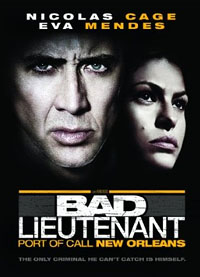DVD Review: Bad Lieutenant: Port of Call New Orleans
 The film Bad Lieutenant: Port of Call New Orleans is an odd but effective take on police corruption and the horrors of drug addiction. The film, now available on DVD and Blu-ray, combines a standard police procedural with elements of quirky, drug-fueled surrealism in a dark commentary about the fine -- and often blurred -- line between police work and criminal behavior.
The film Bad Lieutenant: Port of Call New Orleans is an odd but effective take on police corruption and the horrors of drug addiction. The film, now available on DVD and Blu-ray, combines a standard police procedural with elements of quirky, drug-fueled surrealism in a dark commentary about the fine -- and often blurred -- line between police work and criminal behavior.
Set in post-Katrina New Orleans, the story follows Terence McDonagh (Nicolas Cage), a New Orleans police sergeant who injures his back while trying to rescue an inmate from a flooded jail cell. McDonagh is promoted to lieutenant for his heroism, but along with the promotion comes the prospect of a lifetime of debilitating back pain.
Six months after his promotion, McDonagh is assigned to investigate the execution-style murders of five Senegalese immigrants. By this time, he's already deeply addicted to painkillers, supplementing his prescriptions with OxyContin, cocaine and whatever else he can pilfer from the evidence room or score from suspects he detains. But McDonagh's substance abuse is only one of his problems; when not hustling his next fix, he's begging his bookie (Brad Dourif) to loan him enough money for just one more bet or paying a visit to his equally drug-addled girlfriend, Frankie (Eva Mendes), a high-dollar prostitute.
As McDonagh leads the murder investigation, it's obvious that he's a very skilled cop. But his true talent seems to lie in complicating his own life. As his gambling debts mount, he goes to extreme lengths to pay them off. He has a run-in with one of Frankie's johns, an abusive but wealthy and well connected thug who vows to get revenge when McDonagh steals his money. McDonagh also takes his rogue-cop interrogation methods way too far, and soon both his job and his life are in jeopardy.
While Bad Lieutenant: Port of Call New Orleans is an entertaining and fast-paced thriller, it's also flawed in many ways. The plot often is unbelievable, with too many unlikely alliances and double-crosses. Most of the characters are underwritten, particularly the one-dimensional Frankie, who should have been a much more complex love interest for McDonagh. And the drug-induced hallucinatory scenes, while making clever use of iguanas and breakdancing (yes, iguanas and breakdancing), are more bizarre than funny and don't really fit with the rest of the film.
What saves the film are its many bits of ironic humor and Cage's manic portrayal of the deliciously deranged McDonagh. In what may be his best performance since playing suicidal alcoholic Ben Sanderson in Leaving Las Vegas, Cage wears a dead-eyed, maniacal stare throughout the film, becoming increasingly unhinged as his life unravels. Desperate and crazed, Cage's McDonagh is a thoroughly believable high-functioning addict, somehow staying alive and employed despite living in a perpetual drug-fueled haze. Bad Lieutenant: Port of Call New Orleans isn't the best example of its cop-turned-junkie genre, but it's worth seeing for Cage's performance alone.
Extras: Along with the film trailer and previews of other DVD releases, the DVD includes an interesting collection of photos and an unusual "making of" documentary.
Photography Book: Photos by Lena Herzog includes dozens of photos by director Werner Herzog's wife, Lena. The photos are interesting in that they're not the usual production stills; they're more photojournalistic, as if the photographer were shooting real-life subjects and scenes rather than actors on film sets. The photos have a fascinating newsmagazine-like quality and would look right at home in a Time or Newsweek article about life in New Orleans.
The Making of Bad Lieutenant: Port of Call New Orleans is an enlightening and satisfying documentary, but it's unusual in that it has no narration or real narrative thread. It's merely a collection of behind-the-scenes footage and brief comments from the cast and crew. One interesting revelation is that Herzog almost always shoots on location, using sets only on rare occasions when a location shoot isn't possible or safe. The documentary also reminds viewers that filmmaking can be a hazardous business: During filming of a hallucination scene, an iguana gave Herzog a nasty bite on the hand.
For a slightly different take on the movie, read Jette's theatrical review.

